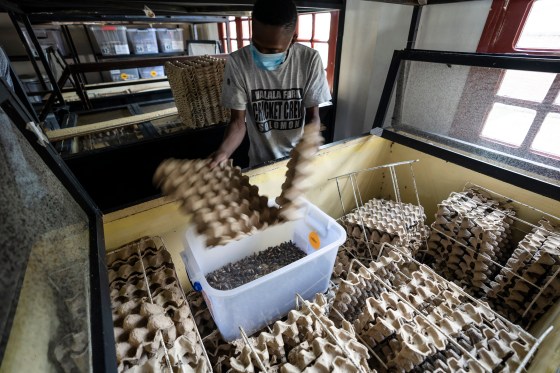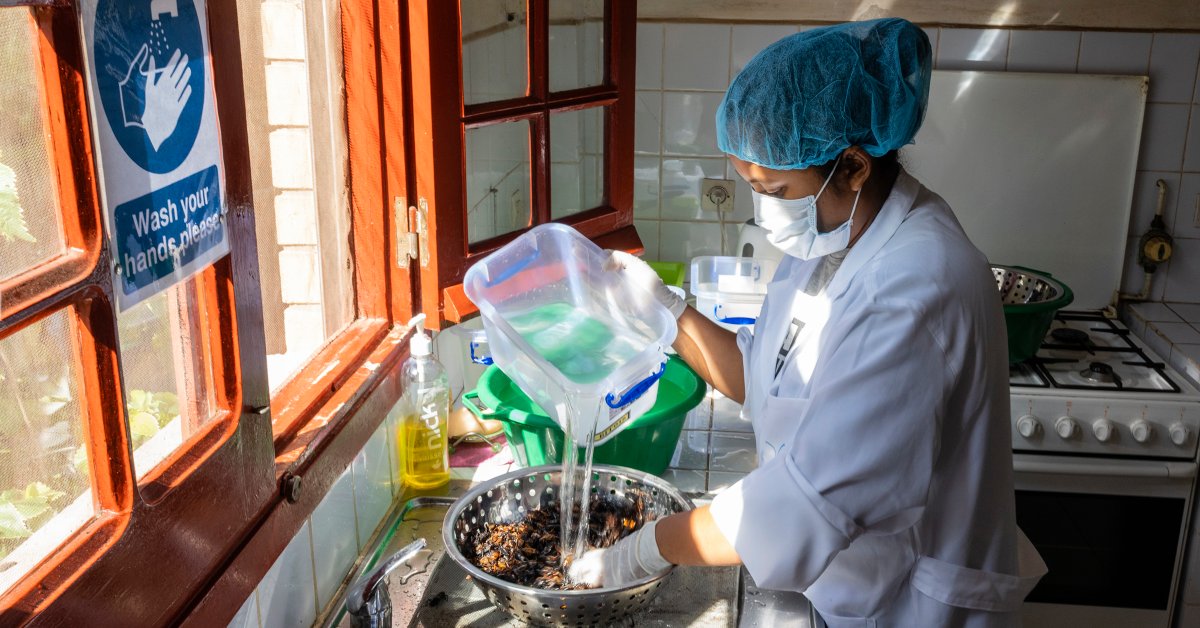[ad_1]
Sylvain Hugel is one of the world’s foremost experts on crickets of the Indian Ocean Islands. So when he received an email from a fellow entomologist in March 2017 asking for help identifying a species in Madagascar that could be farmed for humans to consume, he thought it was a joke. “I’m working to protect those insects, not eat them,” the French academic responded tartly.
But the emails from Brian Fisher, an ant specialist at the California Academy of Sciences, in San Francisco, kept coming. Fisher had been doing fieldwork in Madagascar when he realized that the forests where both he and Hugel conducted much of their research were disappearing. Nearly 80% of Madagascar’s forest coverage has been destroyed since the 1950s, and 1-2% of what remains is cut down each year as farmers clear more trees to make room for livestock. The only way to prevent this, Fisher told Hugel in his emails, was to give locals an alternative source of protein. “If you want to be able to keep studying your insects, we need to increase food security, otherwise there will be no forest left,” Fisher wrote.
His proposal was insect protein. More than two-thirds of Madagascar’s population already eat insects in some form, usually as a seasonal snack. If there were a way to turn that occasional snack into a regular meal by making it easily available, it could help ease pressure on the island’s threatened forests. Crickets, which are high in protein and other vital nutrients, were already being farmed successfully in Canada for both human and animal consumption. Surely Hugel, with his vast knowledge of Indian Ocean crickets, could help identify a local species that would be easy to farm, and, more importantly, might taste good?
For Hugel, his scientific curiosity competed with squeamishness. He knew that crickets were healthy, and that they were high in protein, iron and vitamin B-12. But the psychological barriers were equally high. He started with a roasted, salted cricket. It took three attempts before he could relax enough to actually taste, chew and swallow the cricket. To his surprise, it was good. Really good. Three years later, he laughs at the memory of his first foray into entomophagy. “It changed my life,” he says via video chat from his home in France.
Insects are now a regular part of his daily meals. He spoons cricket powder over his morning yogurt, sprinkles larvae over his salads like bacon bits, and fries up frozen crickets for supper. It also changed the direction of his academic research. While he is still discovering new cricket species, he now regularly publishes papers on the nutritional value of edible insects and findings about best farming practices.
Meanwhile, the cricket farm he helped Fisher launch is up and running in Madagascar’s capital Antananarivo, producing several pounds of ground cricket meal a day. The protein-packed, fiber-rich powder is now being used by international aid agency Catholic Relief Services for country-wide famine relief projects, as well as in school lunch programs and tuberculosis treatment centers where patients often struggle to get adequate nutrition.

In June, Valala Farms, named after the local word for cricket, will expand onto an even bigger campus, with 25,000 square feet dedicated to cricket cultivation (enough to produce 31,000 pounds of powder each year, or about 551,000 meals), as well as an educational program to train future cricket farmers. The attached research center is tasked with identifying which of Madagascar’s 100 or so edible bugs have the right combination of taste, healthiness and farmability. “For me entomophagy is the very solution for Madagascar,” says Hugel. “There is no way to save the forests without taking care of the people who live near them, and that means giving them food security.”
A six-legged solution to world hunger
In seeking to protect Madagascar’s forests, Fisher and Hugel may have found a solution to one of the world’s most pressing problems. The United Nation’s Food and Agriculture Organization [FAO] says that agricultural production worldwide will have to increase by 70% in order to feed a global population expected to reach 9.1 billion by 2050. Yet agriculture is one of the biggest drivers of natural destruction, threatening 86% of the 28,000 species most at risk of extinction, according to a new report by the UK-based policy institute Chatham House and the UN environment program.
Demand for animal protein in particular is increasing the strain on the environment: 80% of the world’s farmland is used to raise and feed livestock, even though animals only account for 18% of global calorie consumption. Decreasing meat production, says the report, would remove pressure to expand livestock operations while freeing up existing land to restore native ecosystems and increase biodiversity.
There is a sustainable alternative to going meat-free, the FAO says: edible insects. Grasshoppers, crickets and mealworms are rich in protein, and contain significantly higher sources of minerals such as iron, zinc, copper, and magnesium than beef. Yet pound for pound they require less land, water and feed than traditional livestock. Insect farming and processing produces significantly lower greenhouse gas emissions. Not only do insects produce less waste, their excrement, called frass, is an excellent fertilizer and soil amender. Agnes Kalibata, the UN Secretary-General António Guterres’ special envoy for the 2021 Food Systems Summit, says that farming insects could provide an elegant solution to the intertwined crises of climate change, biodiversity loss, hunger and malnutrition. “Insects are 60% dry weight protein. I mean, honestly, why wouldn’t we use them?” she says. “But we have to be able to put them in a form that is acceptable to different cultures and different societies.”
Just as in Madagascar, there are technical and cultural barriers to overcome before bugs compete with beef (or any other meat) for space on the global dinner plate. While two billion people, mostly in Africa, Latin America and Asia, already eat insects, in Europe and North America bugs are more likely to be associated with filth, not food. But attitudes are starting to change. Canada’s nationwide grocery chain Loblaws has been stocking locally produced cricket powder since 2018, and in January the European Union food safety agency declared yellow mealworms safe for human consumption, allowing producers to sell insect-based foods throughout the continent. Analysts at Barclays Bank now estimate that the insect protein market could reach $8bn by 2030, up from less than $1bn today. Still, that’s a fraction of beef’s $324 billion.

In order to compete, manufacturers will have to figure out how to successfully market bugs to consumers. The sustainability halo and health aspects may be enough for some, but are unlikely to work on a wider scale, says Cortni Borgerson, an anthropology professor at Montclair State University in New Jersey. “You can’t just say, ‘this source of protein you’ve been eating all your life? Well you can’t have that anymore. Here’s another source, and it’s got six legs instead of four.’ That will never work.” The goal, she says by video chat from New Jersey, should be “to find something that people would rather be eating, or would like just as much.” In other words, insects have to taste at least as good as what they are meant to replace.
In the taste stakes, crickets still come up short. Fried and dusted with chili lime or nacho spice, they don’t taste much different from say, corn nuts or extra crispy shrimp. In powder form, it has a mild, nutty flavor and is best used like a protein boost, sprinkled over porridge, stirred into a vegetarian chili or folded into banana bread batter. Devotees say they can’t get enough, but even they admit that crickets may have a hard getting past that most damning of descriptions—a meat alternative. Madagascar, however, has a better contender: the bacon bug.
A bug fit for a taco
Thirteen years ago, while working on her PHD dissertation in Madagascar’s Masoala Peninsula, Borgerson encountered a problem. Locals in the UNESCO World Heritage Site were eating lemurs and other endangered animals to add protein to their otherwise spare diets. In search of sustainable substitutions, she canvassed residents about other meats they liked to eat. Chicken and pork often came up, but so did an unfamiliar item: sakondry. When Borgerson asked what it was, a few of the locals came back with a plate piled high with plump fried bugs. As a Midwesterner with a rather tame palate, to Borgerson the idea of eating them was appalling. But her prohibition against refusing a meal soon kicked in, she recalls. To her surprise, they were delicious, with a taste and consistency not unlike cubes of pork belly she would fry up back home—“crunchy on the outside, with that fatty meatiness of bacon in the middle.” Even her kids like it, she says, “which is saying a lot for American children.”
The villagers loved sakondry, but the bug wasn’t always easy to find. The solution to stopping lemur hunting, Borgerson realized, was not “four legs bad, six legs good,” but rather, how to make something the villagers already wanted to eat easier to get. Sakondry had never been studied, so Borgerson started working with entomologists like Fisher and local conservation groups to figure out the insect’s life cycle and feeding habits. Once they discovered the ideal host plant, a kind of native bean, the villagers started planting it among their crops and along local pathways. With a ready supply of tasty protein growing just beyond the front door, villagers had less reason to go to the forest to hunt. Two years on, says Borgerson, who plans to publish a paper on her findings, lemur poaching in the area has gone down by 30-50%.
Farming insects is not the only solution for Madagascar’s threatened forests, says Tiana Andriamanana, Executive Director of the Malagasy conservation organization Fanamby. Education and stronger environmental protection laws are equally important. But it’s a start. “We need to consider alternatives. The number of people in Madagascar, in the world, is growing. We can’t continue to eat meat at this rate, but we don’t all want to be vegan either.”
Sakondry’s taste profile seems tailor-made for the American palate; Borgerson recommends it as a filling for in tacos. Yet she is not suggesting that midwestern ranchers switch from bulls to bugs anytime soon. Instead she is pointing to what will reduce overall meat consumption globally: not prohibition, not guilt, but finding alternatives that are equally delicious. “You want to make it easier for individuals to make the choices that they would rather be making,” she says. In Masoala, that was sakondry. Other communities and regions have different preferences and, especially in drought-stricken areas, needs. That’s where Fisher, the ant-specialist-turned-cricket-farmer comes in.

Though he set out to save forests, Fisher’s cricket powder is doing more to alleviate famine and improve nutrition in Madagascar. His production facility is in the country’s urban center, far from the forested regions where locals struggle to find alternatives to hunting and clear cutting grazing grounds. To really have an impact, he says, farmed insects not only have to be as good as meat, they also have to be easy to grow, and hyper-local. At the Valala Farms research center, scientists, biodiversity specialists and entomologists are working together to identify the most promising edible insects for each climatic region, and figuring out how to farm them at scale. His goal, he says, is to develop an “insect toolkit” that can be adapted to local needs, whether it’s protein powder to address malnutrition, a meat alternative, grubs for a chicken farm, or something that can turn brewery waste into an additive for depleted soils. “We are trying to take advantage of 300 million years of insect evolution,” he says. “We want that whole spectrum in our toolkit so that we can go and offer solutions wherever we go, in Madagascar and across Africa—wherever you have poverty combined with malnutrition and biodiversity issues.”
And why stop in Africa — or Earth, for that matter? People are so quick to imagine themselves going to other planets if things get really bad here on Earth, he says. “But what would you eat on Mars? You would have to design systems to produce protein, and insects are the most efficient.” He pauses his rapid-fire delivery to make a mental note: “I should write a proposal to NASA to do research on what insect would be the most efficient for converting protein in space travel.”
The hatching of a trend
It may be a while yet before sakondry are sent to space. In the meantime, entomophagy advocates say a cultural shift is already in the works, particularly among the young and adventurous urbanites who will be setting food trends for generations to come. “It’s not going to happen overnight, and it’s never going to 100% replace meat, but those of us who are health conscious and environmentally aware have already started making that transition,” says biologist Jenna Jadin, who wrote Cicada-licious, a cookbook featuring cicada dumplings and other treats, just in time for the 2004 hatching of Washington D.C.’s 17-year cicada cycle (the next hatching is this summer. Get your skillets ready).
The cookbook was semi-satirical, penned in part to demystify the phenomenon. At the time the idea of eating bugs was outrageous. These days, her local organic grocery store has a whole aisle dedicated to insect products: chocolate-covered mealworms, cricket pasta, peanut butter-cricket balls and a line of cricket chips called Chirps. And one of America’s most famous chefs, José Andrés, has been serving chapulines, sauteed grasshoppers, at his Mexican restaurant Oyamel since 2004.
Food culture does change. Five hundred years ago, Italians thought tomatoes were poisonous. In the 1800s, Americans considered lobsters to be trash food and fed them to prisoners. Few cultures ate raw fish 50 years ago; now sushi is ubiquitous. Insects are likely to follow the same trajectory, says Fisher, who suggests salt-roasted crickets served with beer as the ideal “gateway bug.” The sustainability factor, the health aspects, those are the angles that will make people want to try edible insects, he says. The rest is easy. “If it’s done right, they will keep coming back for more, because it tastes really good.”
[ad_2]
Source link





